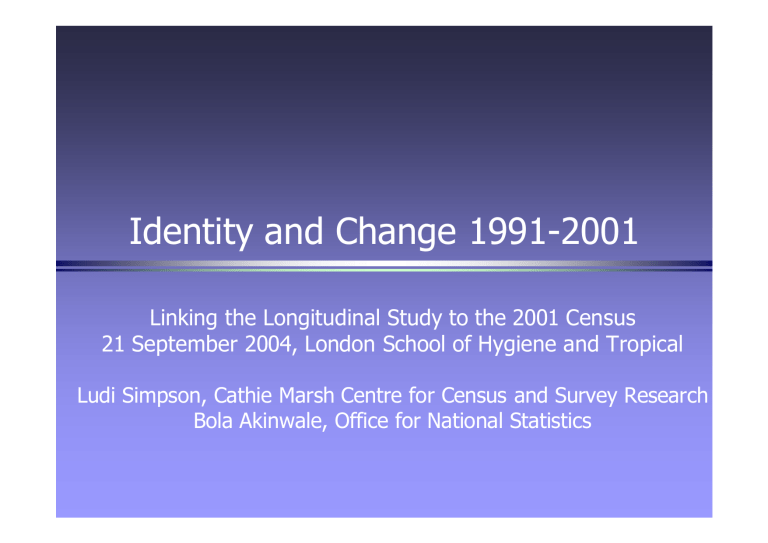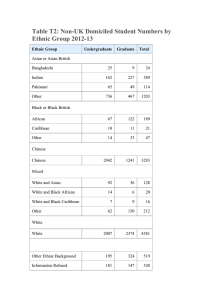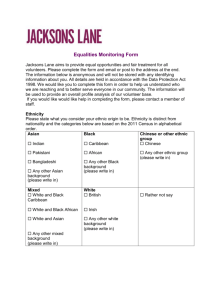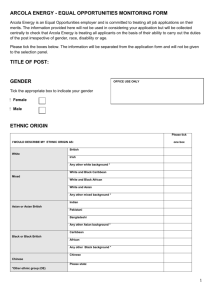Identity and Change 1991-2001
advertisement

Identity and Change 1991-2001 Linking the Longitudinal Study to the 2001 Census 21 September 2004, London School of Hygiene and Tropical Ludi Simpson, Cathie Marsh Centre for Census and Survey Research Bola Akinwale, Office for National Statistics 1991 Census Ethnic group Please tick the appropriate box White Black-Caribbean Black-African Black-Other _______________ Indian Pakistani Bangladeshi Chinese Any other ethnic group _______________ If the person is descended from more than one ethnic or racial group, please tick the group to which the person considers he/she belongs, or tick the ‘Any other ethnic group’ box and describe the person’s ancestry in the space provided. 2001 Census What is your ethnic group? Choose one section from A to E, then tick the appropriate box to indicate your cultural background. A White British Irish Any other White background _______________ B Mixed White and Black Caribbean White and Black African White and Asian Any other Mixed background _______________ C Asian or Asian British Indian Pakistani Bangladeshi Any Other Asian Background _______________ D Black or Black British Caribbean African Any other Black background _______________ E Chinese or any other ethnic group Chinese Any other _______________ Identity and Change 1991-2001 Questions that we have been asked l Which categories should we put together when comparing 1991 and 2001? l Is there a stable transition matrix between ethnic groups, perhaps age-specific? l Is instability associated with other variables, including life events? Identity and Change 1991-2001 Sources of instability l l Conscious change of ethnicity Question change l l l New and different categories Coding of write-in answers Unreliability – measure twice with different results l l l l Response error Question ambiguity Transcription and coding errors Erroneous editing and imputation White Bangladeshi Pakistani Indian Chinese Black Caribbean Black African Black Other 100 90 Median of 7 general researchers 80 70 60 50 40 30 20 10 0 Of those who gave ethnic group X in 1991, what % remained X in 2001? Median of 5 ethnicity researchers White Bangladeshi Pakistani Indian Chinese Black Caribbean Black African Black Other 100 Median of 7 general researchers 90 80 70 Median of 5 ethnicity researchers 60 50 40 30 20 10 0 LS Of those who gave ethnic group X in 1991, what % remained X in 2001? Identity and Change 1991-2001 Measures of stability LS forward linkage Degree of fit % keeping X Marginal fit 2001/1991 89.1% White 99.5% 99.8% 69.3% Caribbean 77.2% 93.2% 61.5% African 77.4% 93.3% 72.8% Other Black 8.3% 41.7% 80.6% Indian 91.0% 97.2% 73.3% Pakistani 91.9% 99.4% 70.9% Bangladeshi 93.4% 98.5% 70.4% Chinese 91.0% 95.8% 67.9% Other Asian 33.6% 102.7% 73.7% Other 7.0% 36.6% Stability (% keeping their label): 98.0% Mean degree of fit: 67.0% Identity and Change 1991-2001 Stability of sex, country of birth and ethnic group Number in 1991 Census Classification Sex Degree of fit Male 198,427 376 99.8% Female 218,339 356 99.8% 384,076 1,243 99.7% 27,937 702 97.5% White 392,582 2,122 99.5% Other 24,932 1,467 94.1% Country of birth UK Overseas Ethnic group Number not in this category in 2001 Stability Mean degree of fit 99.8% 99.8% 99.5% 98.6% 99.1% 96.8% Identity and Change 1991-2001 How much of 10-year instability is due to unreliability and question change? 1991 Census Validation Survey LFS with 2001 question LS 2001 White 99.5 Black 76.1 Asian 97.5 Other 37.9 Mean 77.75 Identity and Change 1991-2001 How much of 10-year instability is due to unreliability and question change? 1991 Census Validation Survey LFS with 2001 question LS 2001 White 99.6 99.5 Black 88.0 76.1 Asian 98.7 97.5 Other 78.1 37.9 Mean 91.1 77.75 Identity and Change 1991-2001 How much of 10-year instability is due to unreliability and question change? 1991 Census Validation Survey LFS with 2001 question LS 2001 White 99.6 99.3 99.5 Black 88.0 82.6 76.1 Asian 98.7 95.2 97.5 Other 78.1 26.9 37.9 Mean 91.1 76 77.75 Identity and Change 1991-2001 Comparison 1991-2001 l Use full transition probabilities in either direction? l E.g. 0.33% of 1991 White became 2001 Mixed — l Mixed 2001 more than double the write in Mixed of 1991 l Irish-born not equal to Irish in 2001 — l But will vary by ethnic composition of population: age and area Nor to Irish descent: need to understand this example of socialisation of ethnicity Allocate new 2001 categories to 10 1991 categories l White – 3 categories, fit best with 1991 White — l 1991 Other loses most to 1991 Other White Mixed – four categories Identity and Change 1991-2001 Mixed 1991-2001 l No clear correspondence l l 1991 White contributes most to 2001 Mixed 1991 write-in Mixed contributes less than 50% to each 2001 Mixed — — l 1991 write in Asian/White all coded to Other-Other 1991 write in Black/Other divided between Black and Other-Other Add to non-residual categories? l Too big in 2001: poor marginal fit Identity and Change 1991-2001 Alternative allocation of Mixed categories Overall Stability 16 categories as in 2001 Census 14 categories. 3 White categories together 10 categories, allocating 2001 Mixed to other categories as follows Mean degree of fit 4.5% 57.1% 98.0% 67.0% Chisquared fit of margins 2001 African /White 2001 Caribbean /White 2001 Asian /White 2001 Other Mixed Other Black Other Black Asian Other Other 98.1% 72.1% 568.7 Dorling and Rees 2003, Polarisation African Caribbean Asian Other Other Black 98.1% 68.7% 1007.3 Dorling and Thomas 2004, Atlas African Other Black Asian Other Other Black 98.1% 71.3% 1319.3 Identity and Change Project 2004 Other Black Other Black Other Other 98.2% 73.6% 279.1 Greater London Authority 2003 Identity and Change 1991-2001 Alternative allocation of Mixed categories Overall Stability 16 categories as in 2001 Census 14 categories. 3 White categories together 10 categories, allocating 2001 Mixed to other categories as follows Mean degree of fit 4.5% 57.1% 98.0% 67.0% Chisquared fit of margins 2001 African /White 2001 Caribbean /White 2001 Asian /White 2001 Other Mixed Other Black Other Black Asian Other Other 98.1% 72.1% 568.7 Dorling and Rees 2003, Polarisation African Caribbean Asian Other Other Black 98.1% 68.7% 1007.3 Dorling and Thomas 2004, Atlas African Other Black Asian Other Other Black 98.1% 71.3% 1319.3 Identity and Change Project 2004 Other Black Other Black Other Other 98.2% 73.6% 279.1 Greater London Authority 2003 Identity and Change 1991-2001 Are the residual categories of use for comparisons over time? l l l Less than half retained their 1991 label By design, a mixture of ambiguous populations Other Black, Other l l l Now dominated by mixed groups Poor degree of fit, poor marginal fit Other Asian l l l 1991 and 2001 totals similar Only one third kept their label Coding changes: 2001 separate box under S Asian boxes — Born in UK: 1991: 22% 2001: 31% — Born in South Asia 1991: 20% 2001: 37% — Born in Far East: 1991: 40% 2001: 2% Identity and Change 1991-2001 Recommendation: 7 categories for comparison, 1 residual l White Briton, Irish, Other White ˜ White l All Mixed and residual categories in Other l Other not intended for comparison 1991-2001 Identity and Change 1991-2001 Fewer categories? White, Black, Asian, Other? l Avoid when possible l But external data with small sample sizes or broad categories l Choose classification according to context l Hierarchical from 10/10 is not optimal l l l Start from 16/10 Black to include Black Other Asian to include Asian Other? l Allow different allocation in 1991 and 2001 Identity and Change 1991-2001 A 4-category classification with high degree of fit l White: White Britons, Irish, Other White l Black: Caribbean, Black, Caribbean/White, African/White, Other Black l Asian: Indian, Pakistani, Bangladeshi, Asian/White, Chinese, Other Asian l Other: Other, Other Mixed Identity and Change 1991-2001 For LS users l Will suppressed small cells cause me problems when comparing classifications across time? l l In the Longitudinal Study, which ethnic group should I use (as a demographic covariate)? l l l l In this study, the changes were of interest, and often suppressed (less than three) from cell and total. Context – which behaviour is explained by ethnic group? Most recent ethnic group is the most current conception Model the uncertainty Imputation: should I include it? l It was correct only for Whites; exclude imputed records Identity and Change 1991-2001 Impact and success of imputation Imputed to a different category N % of imputed % of all records 8,027 201 2.5% 0.1% 167 117 70.1% 3.4% Black African 48 45 93.8% 3.6% Black Other 74 73 98.6% 5.9% Indian 238 121 50.8% 1.4% Pakistani 182 91 50.0% 2.1% Bangladeshi 67 40 59.7% 2.4% Chinese 18 16 88.9% 1.4% Other groups - Asian 43 36 83.7% 2.7% Other groups - Other 80 80 100.0% 3.9% 8,944 820 9.2% 0.2% 1991 category White Black Caribbean All groups Imputed 2001 Identity and Change 1991-2001 Correlates of change in ethnic group l How is change in ethnic group label associated with biographical factors and social circumstances? l Measurement of change constrained by questions asked in 1991 and 2001 Identity and Change 1991-2001 Correlates of change in ethnic group: Age l l l Across all ethnic groups, change was most likely for people aged 60+ Among the main ethnic minorities, people aged 0-14 in were more likely to change ethnic identity than other people under 60 Change was more likely for 1991 dependent children than for other members of household Identity and Change 1991-2001 Correlates of change in ethnic group: Country of birth l l l UK-born were more likely to change ethnic group than those born outside UK Change was least likely for people born in countries of birth associated with their ethnic group label Among White people 1.7% of those born outside the UK changed their ethnic group, compared with 0.1% of the UK-born Identity and Change 1991-2001 Other correlates of change in ethnic group l l l l 23% of those who lived in a multiple ethnic group household at either Census changed group compared with 0.4% of those in single ethnic group households at both points Most stable were in all White (0.1% changed) and all Bangladeshi households (3.5% changed) Identity was most stable for members of the largest religion within an ethnic group 4.4% of those living in London in 2001 changed ethnic group compared with 0.7% of those outside London Identity and Change 1991-2001 Conclusions l Ethnic group question l l l l l Comparison 1991-2001 l l l Reliability is not complete, probably improved on 1991 Residual categories not useful Works unambiguously only for Whites Can expect further changes to question Favoured 7+Other categories (1 other or 3 other) No formulaic conversion of 1991 to 2001 Who changes ethnicity? l l l UK-born Living in London Poorly fitting labels



